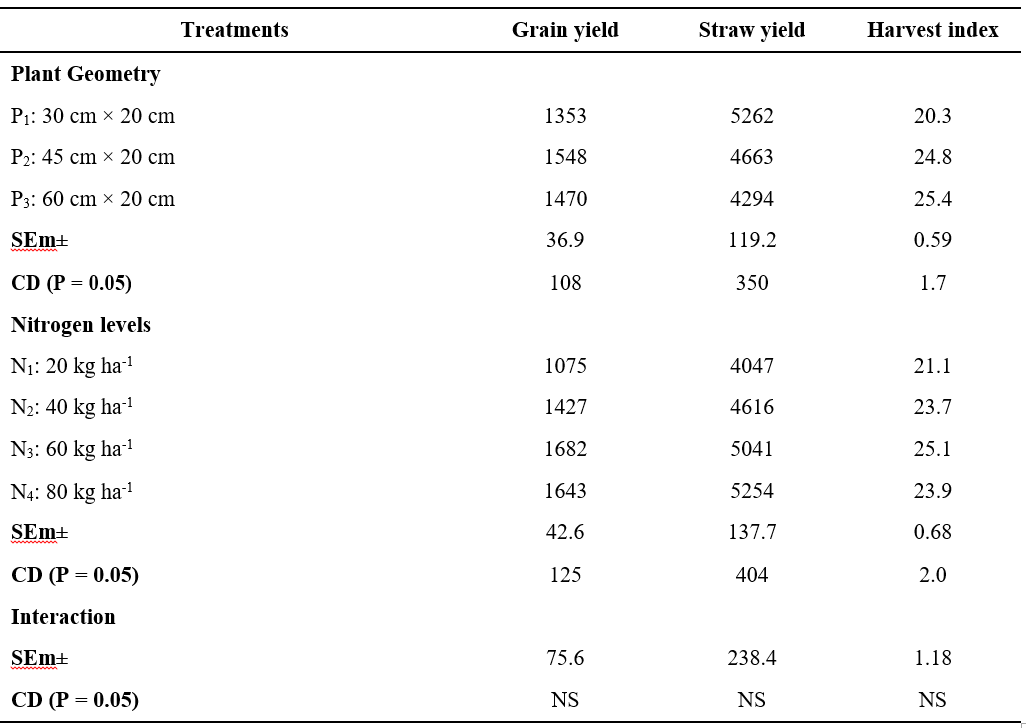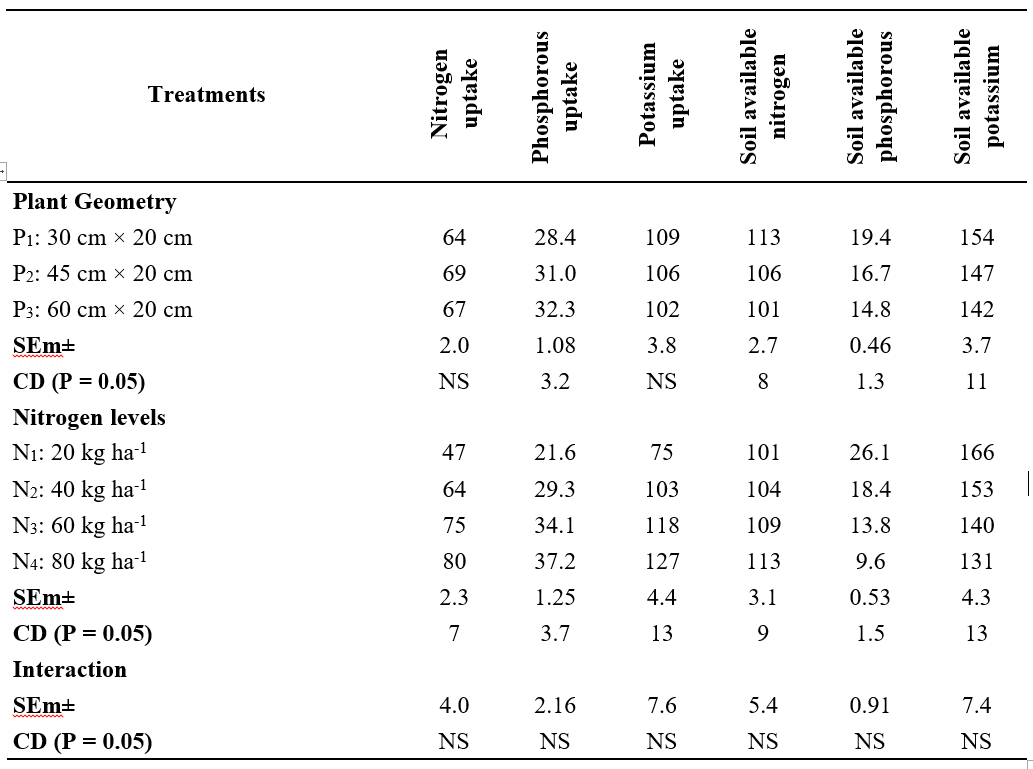Effect of Plant Geometry and Nitrogen Levels on Yield, Nutrient Uptake and Post Harvest Soil Available Nutrient Status of Browntop Millet Under Southern Agro-Climatic Zone of Andhra Pradesh
0 Views
N. PAVAN KUMAR*, S. HEMALATHA, D. SUBRAMANYAM, A.R. NIRMAL KUMAR AND G.KARUNA SAGAR
Department of Agronomy, S.V. Agricultural College, ANGRAU, Tirupati 517502
ABSTRACT
A field experiment was conducted at S.V. Agricultural College Farm, Tirupati, Acharya N.G. Ranga Agricultural University, Andhra Pradesh, India during kharif season of 2020 to analyze the yield, nutrient uptake and post-harvest soil available nutrient status of browntop millet under varied plant geometry and nitrogen levels. The treatments include three plant geometry viz., P1 (30 cm × 20 cm), P2 (45 cm × 20 cm) and P3 (60 cm × 20 cm) and four nitrogen levels, viz., 20 kg N ha-1 (N1), 40 kg N ha-1 (N2), 60 kg N ha-1 (N3) and 80 kg N ha-1 (N4). Plant geometry P2 resulted in significantly highest grain yield but it was statistically on par with P3 and significantly superior straw yield was recorded with P1 plant geometry.[ Uptake of higher nitrogen and potassium was recorded with P2 and P1 plant geometry respectively with no significant disparity among P1, P2 and P3, while phosphorus uptake was recorded higher with P3 plant geometry which was on par with P2. Significantly lower amount of post harvest soil available nutrients were observed in P3 plant geometry which was on par with P2. Among the nitrogen levels tested, application of 60 kg N ha-1 produced higher grain yield which was on par with application of 80 kg N ha-1, higher straw yield and nutrient uptake was recorded with 80 kg N ha-1 but it was statistically comparable with 60 kg N ha-1.]
KEYWORDS: Browntop millet, nutrient uptake, plant geometry, nitrogen levels and post-harvest soil available nutrients.
INTRODUCTION
Browntop millet (Brachiaria ramosa (L.) Stapf. or Urochloa ramosa (L.) R.D. Webster) is an annual hardy, heat and drought tolerant minor millet crop that grows to a height of 90 to 150 cm. Unlike other millets, brown-top millet has a unique quality as it can be grown in the partial shade which ensures wider choice of adoption even in fruit orchards or in agro-forestry system. Crop matures early approximately 75-90 days. It is known for its rapid forage production (hardly 50 days duration) act as a cover crop in plantation crops for soil erosion control and for high straw production. 100 grams of browntop millet contains 8.98, 1.89, 3.90, 8.20 and 71.32 per cent of protein, fat, minerals, crude fiber and carbohydrates respectively.
Low productivity in browntop millet is a major problem due to lodging during kharif normally when it is sown at closer spacing or broadcasting. The productivity of brown top millet can be increased by applying of fertilizers at optimum dose, especially nitrogen is required for initial establishment, vigorous and robust tillers with
broad leaves which enhances the quality and productivity of grain. Therefore, the optimum plant geometry and nitrogen management provides favourable environmental conditions to the crop during various growth and developmental stages, resulting in better performance and enhanced productivity of browntop millet.
MATERIAL AND METHODS
The present field experiment was carried out at dryland farm, S.V. Agricultural College, Tirupati of Acharya N.G. Ranga Agricultural University. The experiment was laid out in a random block design with factorial concept with twelve treatment combinations and replicated thrice. The treatments include three plant geometry viz., P1 (30 cm × 20 cm), P2 (45 cm × 20 cm) and P3 (60 cm × 20 cm) and four nitrogen levels, viz., 20 kg N ha-1 (N1), 40 kg N ha-1 (N2), 60 kg N ha-1 (N3) and 80 kg N ha-1 (N4). The experimental field was sandy loam in texture which is low in organic carbon (0.38%). The soil is alkaline in reaction (pH 7.7), low in available N (151.0 kg ha-1), medium in available phosphorus (207.0 kg ha-1) and potassium (34.0 kg ha-1). The variety of browntop millet tested was GPUBT-6. A total rainfall of 859.0 mm was received in 33 rainy days during the crop growing period. Recommended dose of fertilizers was 40-20-20 kg N, P2O5 and K2O ha-1. The nutrients were applied in the form of urea, single super phosphate and muriate of potash. Available soil nitrogen (N) was estimated by the method described by Subbiah and Asija (1956) and the nitrogen status was expressed in kg ha-1. Soil available phosphorus was determined as described by Olsen et al. (1954) using spectrophotometer and expressed in kg ha-1. Soil available Potassium was estimated by neutral normal ammonium acetate extraction method using Flame Photometry (Jackson, 1973) and expressed in kg ha-1.Plants from each treatment in the plot were selected at random and tagged for taking the observation viz, nutrient uptake of NPK. The oven dried samples of plants material were ground in a willey mill and analyzed for N, P and K contents. The nitrogen, phosphorus and potassium uptake were calculated by multiplying the nutrient content of the plant sample with corresponding total dry matter and expressed in kg ha-1. The total nitrogen content in the plant sample was estimated by the Micro Kjeldal method as suggested by (Association of Official Agricultural Chemists (AOAC), 1960). The total phosphorus content in the plant sample was estimated with vanado-molybdo phosphoric acid method by Jackson (1973). The total potassium content in the plant sample was estimated with triple acid digestion method using Flame Photo Meter as suggested by Jackson (1973). The data collected were analyzed statistically following the procedure given by Panse and Sukhatme (1985) wherever the treatmental differences were significant, critical differences were worked out at five per cent probability level. Treatment differences that were not significant are denoted as NS.
RESULTS AND DISCUSSION
Grain yield
Grain yield of browntop millet varied significantly due to plant geometry as well as nitrogen levels tried, while the interaction effect was found to be non significant.
The highest grain yield of browntop millet was realized with plant geometry P2 (45 cm × 20 cm) which was statistically on par with that of P3 (60 cm × 20 cm). This might be due to optimum plant geometry provided favourable microclimate which enables the individual plant in efficient utilization of growth resources like light,
moisture and nutrients which in turn to achieve the maximum productivity. Even though all the yield attributes were maximum in wider plant geometry, panicles on late formed tillers were not attained full maturity there by reduced the grain yield per unit area when compared to optimum plant geometry. Whereas severe intra-plant competition and lodging at reproductive stage due to higher plant height might have negative effect on grain yield under closer plant geometry. The results were in confirmity with the findings of Natarajan et al. (2019) and Santosh et al. (2020).
Among nitrogen levels tested, higher grain yieldwas registered with the application of 60 kg N ha-1 (N3) which was comparable with 80 kg N ha-1 (N4) followed by 40 kg N ha-1 (N2) which was in turn exhibited significant difference to both of them. Higher yield with increase in nitrogen level up to 60 kg N ha-1 (N3) might be due to the reason that better availability and uptake of nutrients resulted in enhanced chlorophyll synthesis, leaf area, photosynthetic efficiency, better growth and dry matter production which ultimately led to efficient partitioning and translocation of photosynthates from source to sink. Application of 80 kg N ha-1 (N4) resulted in more vegetative growth which in turn reduced the grain yield when compared to 60 kg N ha-1 (N3). Significantly lower grain yield was noticed with 20 kg N ha-1 (N1). The present results are in accordance with the findings of Vimalan et al. (2019) and Anitha et al. (2020).
Straw yield
Varied plant geometry and nitrogen levels exerted significant influence on the straw yield of browntop millet, while their interaction effect was found to be non significant.
Significantly higher straw yield was recorded at P1 (30 cm × 20 cm) than that of P2 (45 cm × 20 cm). This might be due to closer plant geometry which resulted in taller plants with high dry matter and more plant population per unit area and ultimately increased the straw yield. These results were in accordance with the findings of Mane et al. (2019) and Sanjay et al. (2021). The lower straw yield was observed with the P3 (60 cm × 20 cm) plant geometry which was statistically differed from other plant geometry tried.
Under varied nitrogen levels tested, straw yieldwas significantly higher with the application of 80 kgNha-1 (N4) which was comparable with 60 kg N ha-1 (N3)
Effect of plant geometry and ‘N’ levels on yield, nutrient uptake and post harvest nutrient availability of browntop milllet
Table 1. Grain yield, straw yield (kg ha-1) and harvest index (%) as influenced by varied plant geometry and nitrogen levels in browntop millet

followed by 40 kg N ha-1 (N2) which in turn statistically not comparable with 60 kg N ha-1 (N3). The increased dose of nitrogen leads to higher availability of nitrogen along with enhanced absorption of other nutrients. Nitrogen plays a key role in the synthesis of chlorophyll and higher availability of nitrogen tends to increase leaf area, plant height, number of tillers and dry matterdue to higher photosynthetic efficiency ultimately increased growth and straw yield. The similar results were reported by Prabudoss et al. (2017) and Saikishore et al. (2020). Significantly lower straw yield was noticed with 20 kg N ha-1 (N1).
Nutrient uptake
Nutrient uptake of browntop millet differed significantly due to varied plant geometry and nitrogen levels, while the interaction effect found to be non significant.
Nitrogen uptake was higher with plant geometry P2 (45 cm × 20 cm) which was comparable with P3 (60 cm × 20 cm) and P1 (30 cm × 20 cm)plant geometry. Phosphorus uptake was higher in wider plant geometry P3 (60 cm × 20 cm) which was statistically superior to P1 (30 cm × 20 cm) but was on par with that of P2 (45 cm × 20 cm). Lower uptake of nitrogen and phosphorus was noticed with P1 (30 cm × 20 cm) plant geometry. Whereas potassium uptake was higher with P1 (30 cm × 20 cm) plant geometry which was statistically on par with that of P2 (45 cm × 20 cm) and P3 (60 cm × 20 cm) plant geometry. Lower potassium uptake was noticed with P3 (60 cm × 20 cm). The difference in uptake of potassium was might be due to higher per cent of potassium content in straw. These findings were in conformity with Natarajan et al. (2019) and Thakur et al. (2019).
Table 2. Nutrient uptake (kg ha-1) and post-harvest soil available nutrient status (kg ha-1) at harvest as influenced by varied plant geometry and nitrogen levels in browntop millet

Uptake of nutrients was maximum with application of 80 kg N ha-1 (N4) which was on par with 60 kg N ha-1 (N3) followed by 40 kg N ha-1 (N2) which was inturn significant difference to that of later one. The growth and yield of crop was determined by the presence and availability of nutrients in the soil for uptake. Uptake of nutrients depends on the concentration of ions in the available form in the external medium. Increased levels of nitrogen might be increased the availability of nitrogen ions in the soil solution resulted in higher absorption of P and K along with nitrogen. Similar findings were also observed by Jyothi et al. (2016) and Vimalan et al. (2019). Significantly lower nutrient uptake was noticed with 20 kg N ha-1 (N1).
Post-harvest soil available nutrient status
Varied plant geometry and nitrogen levels have exerted significant influence on the post harvest soil nutrient status (available nitrogen, phosphorus and potassium), while the interaction effect was not statistically traceable.
Post-harvest soil available nitrogen and potassium were higher with P1 (30 cm × 20 cm) plant geometry which was however on par with that of P2 (45 cm × 20 cm followed by P3 (60 cm × 20 cm) which inturn on par with that of P2 (45 cm × 20 cm). The highest post-harvest soil available phosphorous was noticed with P1 (30 cm × 20 cm) followed by P2 (45 cm × 20 cm) with significant disparity between them. This might be due to higher uptake of nutrients by browntop millet in wider plant geometry resulted in lower available nitrogen and potassium in the soil after harvest. Lower post-harvest soil available nitrogen, phosphorous and potassium were recorded with P3 (60 cm × 20 cm). This might be due to large root system in wider plant geometry helped in better absorption of nutrients which in turn exhibited more number of tillers with increased leaf area plant-1.
Post-harvest available soil nitrogen was higher with application of 80 kg N ha-1 (N4) and lower with 20 kg N ha-1 (N1). The difference might be due to increase in nitrogen levels which resulted in overall growth and yield of crop with well developed root system by releasing root exudates helps in mineralization of organic nitrogen by microorganisms, ultimately increase in available nitrogen status of the soil. The highest post-harvest soil available phosphorous and potassium availability were registered with 20 kg N ha-1 (N1) and significantly lower were noticed with application 80 kg N ha-1 (N4). With increase in nitrogen levels, phosphorous and potassium content in the soil after harvest was decreased. This might be due to the reason that higher uptake of phosphorus and potassium with increase in nitrogen level might have limited the availability phosphorous and potassium in the soil after harvest. The similar results were reported by Jyothi et al. (2016) and Anitha et al. (2020).
Finally, it can be concluded that higher grain yield of browntop millet could be achieved with plant geometry of 45 cm × 20 cm along with the application of 60 kg N ha-1on sandy loam soils of Southern Agro-climatic Zone of Andhra Pradesh.
LITERATURE CITED
Anitha, K.V., Chikkaramappa, T., Basavaraja, P.K., Prakash, N.B., Murali, K and Boraiah, B. 2020. Effect of different levels of fertilizers on productivity and nutrient dynamics of brown top millet. International Research Journal of Pure & Applied Chemistry. 21(24): 308-320.
AOAC, 1960. Official methods of analysis of the Association Agricultural Chemists. 9th edition. Washington, 4 D.C.
Jackson, M.L. 1973. Soil Chemical Analysis. Prentice Hall India Pvt. Ltd., New Delhi. 498.
Jyothi, K.N., Sumathi, V and Sunitha, N. 2016. Productivity, nutrient balance and profitability of foxtail millet varieties as influenced by levels of nitrogen. IOSR Journal of Agriculture and Veterinary Science (IOSR-JAVS). 9(4): 18-22.
Mane, M.J., Mahadkar, U.V., Sagavekar, V.V., Jagtap, D.N and Dhekale, J.S. 2019. Economics of finger millet (Eleusine coracana (L) Gaertn) as influenced by land situations, various planting geometry and levels of fertilizer under lateritic soil of konkan region. International Journal of Chemical Studies. 7(6): 838-847.
Natarajan, S., Ganapathy, M., Arivazhagan, K and Srinivasu, V. 2019. Effect of spacing and nutrient sources on system of finger millet (Eleusine coracana) intensification. Indian Journal of Agronomy. 64(1): 98-102.
Olsen, S.R., Cole, C.V., Watanade, F.S and Dean, L.A. 1954. Estimation of available phosphorus in soil by extraction with sodium carbonate. U.S.D.A. Circular. 939.
Panse, V.G and Sukhatme, P.V. 1978. Statistical methods for agricultural workers, ICAR Publication, New Delhi.
Prabudoss, V., Jawahar, S., Shanmugaraja, P and Balaji, 2017. Effect of age of seedlings and spacing on nutrient uptake and post-harvest soil available nutrients in transplanted kodo millet. European Journal of Biotechnology and Bioscience. 5(4): 85-87.
Saikishore, A., Rekha, K.B., Hussain, S.A and Madhavi, 2020. Growth and yield of browntop millet as influenced by dates of sowing and nitrogen levels. International Journal of Chemical Studies. 8(5): 1812-1815.
Sanjay, K.J., Vikram, S., Dhananjay, T., Shruti, G.G and Swathi, P. 2021. Effect of spacing and age of seedling on growth and yield of finger millet (Eleusine coracana L.). Biological Forum – An International Journal. 13(1): 585-589.
Santosh, K.P., Shambhu, P., Mahesh, K.S., Singh, Y.K., Indrajeet K.N and Rakesh, K. 2020. Effect of fertility level, plant density and age of seedling on transplanted pearl millet (Pennisetum glaucum). International Journal of Current Microbiology and Applied Sciences. 9(6): 1124-1131.
- Morphological Characterization of Sesame (Sesamum Indicum L.) Genotypes
- Effect of Liquid Biofertilizers on Productivity of Sesame (Sesamum Indicum L.)
- Profile Characteristics of Stakeholders in the Banana Value Chain: A Gender Analysis
- Studies on Genetic Variability and Genetic Parameters for Grain Yield and Its Components in Foxtail Millet (Setaria Italica (L.) P. Beauv.)
- Morphological Basis for Resistance Against Whitefly in Castor
- Dus Testing of Sesame (Sesamum Indicum L.) Accessions Using Morphological Descriptors

